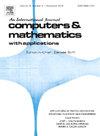以顶点为中心的控制-模拟体积有限差分方法
IF 2.5
2区 数学
Q1 MATHEMATICS, APPLIED
引用次数: 0
摘要
针对二阶椭圆型方程,提出了一类新的顶点中心控制-仿体积多边形网格有限差分方法。这些方案基于混合速度-压力公式。在围绕主要网格顶点构建的双网格控制体上,压力是恒定的。在控制体的表面上,法向速度是恒定的,导致控制体上的局部质量守恒。我们考虑了在控制体积上构造的对称速度积分规则,以及在由初等元与对偶元相交得到的子体积上构造的非对称正交规则。后一种选择允许明确的梯度构建和主要元素内的局部多点通量消除,从而产生一个确定的以顶点为中心的压力系统。在简单、四边形或六面体网格上,这些局部通量方法与经典的基于分段多项式压力有限元基函数的以顶点为中心的控制体积有限元方法密切相关,在某些情况下是等效的。利用模拟有限差分框架分析了所提方法的适定性和精度。我们建立了离散模拟范数下压力和速度的一阶收敛性,以及对称正交规则下压力的二阶超收敛性。一系列数值实验证明了该方法在二维和三维不同程度的各向异性、非均质性和网格复杂性问题上的收敛性。本文章由计算机程序翻译,如有差异,请以英文原文为准。
Vertex-centered control-volume mimetic finite difference methods
We develop a new class of vertex-centered control-volume mimetic finite difference methods on polytopal meshes for second order elliptic equations. The schemes are based on a mixed velocity-pressure formulation. The pressure is constant on dual mesh control-volumes constructed around the primary mesh vertices. The normal velocity is constant on the faces of the control-volumes, resulting in local mass conservation over the control-volumes. We consider both symmetric velocity integration rules constructed over the control-volumes, as well as non-symmetric quadrature rules constructed over sub-volumes obtained by the intersection of primary and dual elements. The latter choice allows for explicit gradient construction and local multipoint flux elimination within the primary elements, resulting in a positive definite vertex-centered pressure system. On simplicial, quadrilateral or hexahedral meshes, these local flux methods are closely related, and in some cases equivalent, to the classical vertex-centered control-volume finite element methods based on piecewise polynomial finite element basis functions for the pressure. The mimetic finite difference framework is utilized to analyze the well posedness and accuracy of the proposed methods. We establish first order convergence for the pressure and the velocity in the discrete mimetic norms, as well as second order pressure superconvergence in the case of symmetric quadrature rules. A series of numerical experiments illustrates the convergence properties of the methods on problems with varying degree of anisotropy, heterogeneity, and grid complexity in two and three dimensions.
求助全文
通过发布文献求助,成功后即可免费获取论文全文。
去求助
来源期刊

Computers & Mathematics with Applications
工程技术-计算机:跨学科应用
CiteScore
5.10
自引率
10.30%
发文量
396
审稿时长
9.9 weeks
期刊介绍:
Computers & Mathematics with Applications provides a medium of exchange for those engaged in fields contributing to building successful simulations for science and engineering using Partial Differential Equations (PDEs).
 求助内容:
求助内容: 应助结果提醒方式:
应助结果提醒方式:


